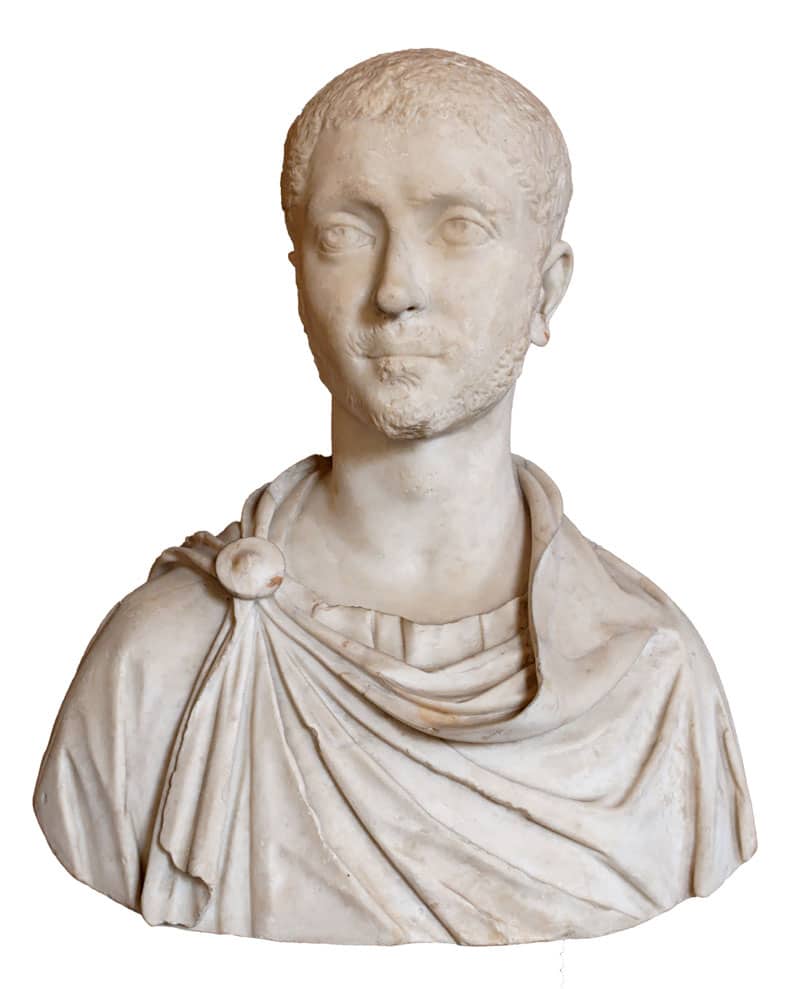Life: AD 208 – 235

- Name: Marcus Julius Gessius Alexianus
- Born on 1 October AD 208 at Arca Caesarea in Phoenicia.
- Consul AD 222, 226, 229.
- Became emperor on 13 March AD 222.
- Wife: Sallustia Orbiana.
- Died in Rome, in March AD 235.
Marcus Julius Gessius Alexianus, known as Alexander Severus was born in AD 208 in Caesarea (sub-Libano) in Phoenicia.
He was the son of Gessius Marcianus and Julia Avita Mamaea, daughter of Julia Maesa.
Just like his cousin Elagabalus, Alexander Severus had inherited the priesthood of the Syrian sun god El-Gabaal.
Alexander Severus as Caesar
Alexander first came to prominence when Elagabalus proclaimed him Caesar (junior emperor) in AD 221. It was when he became Caesar, that the boy Alexianus assumed the name Marcus Aurelius Severus Alexander. His entire elevation was in fact part of a plot by the powerful Julia Maesa, grandmother to both Elagabalus and Alexander, to rid herself of Elagabalus and instead substitute him on the throne with Alexander. It was she, together with Alexander’s mother Julia Mamaea who had persuaded Elagabalus to promote his cousin.
However, emperor Elagabalus soon changed his mind about his supposed heir. Perhaps he discovered that Alexander was the greatest threat to his own life. Or perhaps he simply grew jealous of the popularity his young cousin enjoyed. In either case, Elagabalus soon sought to have Alexander Severus assassinated. But, with the young Caesar guarded by the rich and powerful Julia Maesa, this attempt failed.
Emperor Alexander Severus
Finally, Julia Maesa made her move. The praetorian guard was bribed and Elagabalus, together with his mother Julia Soaemias, were murdered (11 March AD 222). Alexander Severus ascended unopposed to the throne.
The government remained in the hands of Julia Measa, who ruled as regent until her death in AD 223 or 224. With the death of Maesa power passed on into the hands of Julia Mamaea, the young emperor’s mother. Mamaea governed moderately, advised by an imperial council of 16 distinguished senators. And so Elagabalus’ sacred Black Stone was returned to Emesa under her rule. And the Elagaballium was rededicated to Jupiter.
Laws were revised, taxes were marginally lowered and a building and repair program for public works was started. Meanwhile, the senate should see a limited revival of its authority and standing, most of all its dignity as it for the first time in a while was being treated with respect by the emperor and his court.
And yet, despite such good government, encountered serious trouble early on. Rome struggled to accept being ruled by a woman. Was Julia Mamaea’s rule not as firm as that of Julia Maesa, it only encouraged a revolt by the increasingly hostile praetorians. At some point, there was even fighting in the streets of Rome, between the ordinary people and the praetorian guard.

These outrages might well have been the reason why the execution of their commanders Julius Flavianus and Gemininius Chrestus was ordered. Sparked off by these executions, either in late AD 223 or early 224, the praetorians staged a serious mutiny. Their leader was a certain Marcus Aurelius Epagathus. The most prominent victim of the praetorian revolt was the praetorian prefect Domitius Ulpianus.
Ulpianus had been a distinguished writer and jurist, as well as Mamaea’s right-hand man in government. Her chief advisor, Julia Mamaea found herself humiliatingly forced to publicly thank the mutinous Epagathus and was required to ‘reward’ him with the post of governor of Egypt. Later, however, Julia Mamaea and Alexander had their revenge by managing to arrange for his assassination. In AD 225 Mamaea organized a wedding for her son with the daughter of a patrician family, Cnaea Seia Herennia Sallustia Orba Barbia Orbiana.
The bride was elevated to the rank of Augusta in her marriage. And possibly her father, Seius Sallustius Macrinus, also received the title of Caesar.
However, trouble was soon to arise. Its reasons are not quite clear. Either Mamaea was too greedy to share power with anyone else, or perhaps the new Caesar Sallustius was plotting with the praetorians to take power himself. In any case, in AD 227, both father and daughter fled into the camp of the praetorians, where Sallustius was taken prisoner by imperial order and executed. Orbiana was thereafter exiled to Africa. After this episode, Mamaea would not tolerate any potential rival to her power in court.
But apart from such power struggles at court, a far greater threat should emerge. This time from the east. The Parthians finally crumbled and the Sassanids gained supremacy within the Persian empire. The ambitious king Artaxerxes (Ardashir) now sat on the throne of Persia and almost immediately sought to challenge his Roman neighbors. In AD 230 he overran Mesopotamia from where he then could threaten Syria and other provinces. Having at first attempted to negotiate peace, Julia Mamaea and Alexander Severus alas set out for the east in spring AD 231 at the head of a large military force.
Once in the east, a second attempt at a negotiated settlement was made. But Artaxerxes simply sent back the message that he demanded the Romans withdraw from all the eastern territories he claimed. Just as with the praetorians, Alexander and Mamaea struggled to keep control of the army. The Mesopotamian armies suffered all kinds of mutinies and the troops from Egypt, the Legio II ‘Trajan’ also revolted. It took some time to bring these troubles under control before finally a three-pronged attack was launched upon the Persians.
Of the three prongs none fared very well. All three suffered heavy losses. The northernmost column did well by driving the Persians off of Armenia. The central column, led by Alexander Severus himself through Palmyra towards Hatra failed to achieve any significant advance. The southern column meanwhile was wiped out completely along the Euphrates river.
However, the objective of driving the Persians out of Mesopotamia was achieved. Alexander and Mamaea therefore returned to Rome to hold a triumphal march through the streets of the capital in the autumn of AD 233. The military though was little impressed by their emperor’s performance. But already while the war against the Persians had been occupying the emperor and his mother, to the north a new menace had begun raising its head.
Fall of Alexander Severus
The Germans were becoming restless north of the rivers Rhine and Danube. Most of all the Alemanni were cause for worry along the Rhine. So in AD 234 Alexander and Mamaea set out for the north where they joined the legions on the Rhine at Moguntiacum (Mainz). There preparations were made for a German campaign. A bridge of ships was constructed to carry the Roman army across. But Alexander by now knew himself no big general. He therefore hoped that the threat of war alone might be enough to bring the Germans to accept peace.

It worked indeed and the Germans agreed to sue for peace, given that they would be paid subsidies. However, for the Roman army, this was the final straw. They felt humiliated at the idea of buying the barbarians off. Angered, they mutinied and hailed one of their senior officers, Julius Verus Maximinus, emperor. With Alexander Severus camped at Vicus Britannicus (Bretzenheim), Maximinus gathered his troops and marched against him. On hearing this, Alexander’s troops mutinied and turned on their emperor.
Alexander and Julia Mamaea were both murdered by their own troops (March AD 235). Some time later Alexander’s body was returned to Rome where it was laid to rest in an especially made tomb. He was deified by the senate in AD 238.
People Also Ask:
What are some interesting facts about Alexander Severus?
Severus Alexander became emperor when he was around 14 years old, making him the youngest emperor in Rome’s history. Alexander’s grandmother Maesa believed that he had more potential to rule and gain support from the Praetorian Guard than her other grandson, the increasingly unpopular emperor Elagabalus.
How long did Alexander Severus rule?
Alexander Severus (born 209, Phoenicia [now in Lebanon]—died 235, Gaul) Roman emperor from ad 222 to 235, whose weak rule collapsed in the civil strife that engulfed the empire for the next 50 years.
Why is Alexander Severus important?
During his reign, Alexander Severus pursued a policy of peace and diplomacy with Rome’s enemies. He negotiated treaties with the Sassanid Empire in Persia and the Germanic tribes along the Rhine frontier. He also tried to maintain good relations with the Senate and the people of Rome.

Historian Franco Cavazzi dedicated hundreds of hours of his life to creating this website, roman-empire.net as a trove of educational material on this fascinating period of history. His work has been cited in a number of textbooks on the Roman Empire and mentioned on numerous publications such as the New York Times, PBS, The Guardian, and many more.
